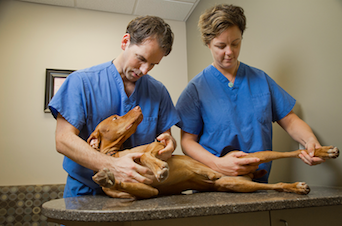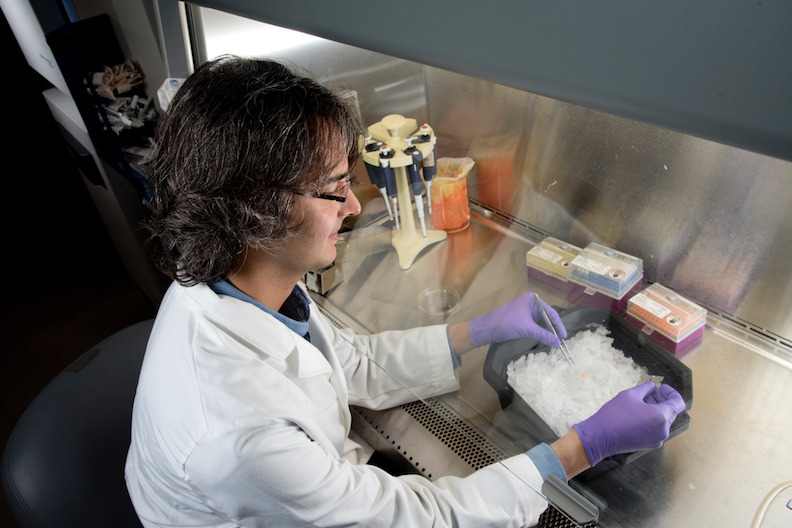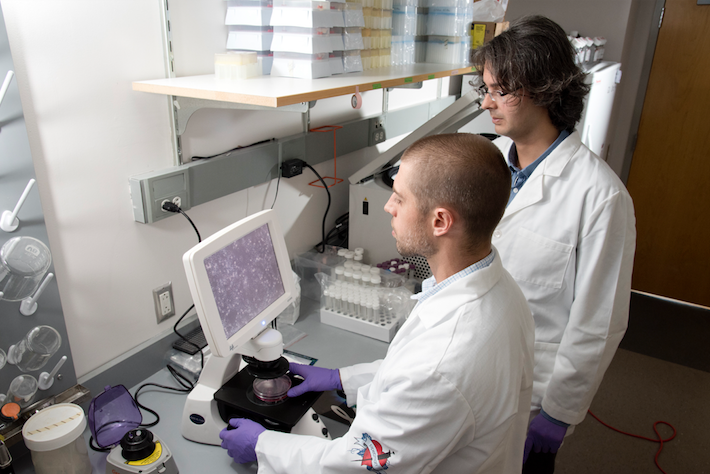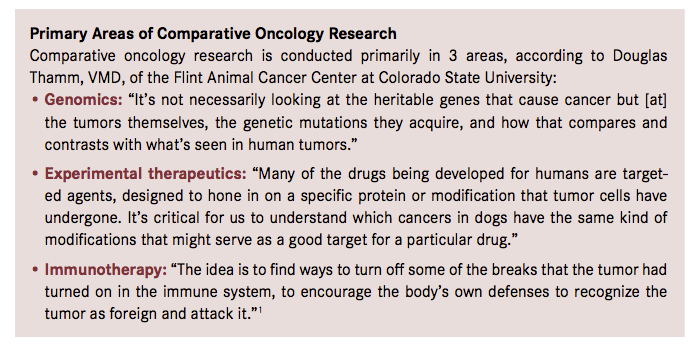Enlisting Dogs in the War on Cancer
Parallels between species have propelled collaboration and coordination in oncology research that is proving beneficial to both people and pets.

Duke surgical oncologist William Eward, DVM, MD, and his wife, Cindy Eward, DVM, DACVS, who practice at Triangle Veterinary Referral Hospital in Holly Springs, North Carolina, perform an orthopedic exam on their dog Virgil. William Eward is also an orthopedic oncologist at Duke.
In the thousands of years they’ve been domesticated, dogs have helped humans in many ways, from herding sheep and cattle to performing search and rescue duties after disasters. Now dogs have begun aiding us in what might be the most important way yet: finding new ways to fight cancer.
The National Cancer Institute (NCI) defines comparative oncology as “the study of naturally developing cancers in animals as models for human disease.” For years, mice have been the major preclinical model for oncologic studies, for several reasons: They can produce 1 litter of 10 to 15 offspring per month, providing a steady supply of research subjects. Since 1 mouse year equals about 30 human years, studies can be conducted at an accelerated rate compared with human trials. And the mouse’s genetic makeup resembles humans’ in many ways.
Of Mice and Models
“Mice are extraordinarily useful for working out pathways and investigating specific genes to learn how they work,” said Cheryl London, DVM, PhD, a research professor in the Ohio State University Department of Veterinary Biosciences. “But the reality is that for some diseases, mouse models have been completely ineffective at translation from what you see in the mouse to what you see in people.”
Tumors usually must be induced with radiation or chemicals in mice, because they don’t generally arise spontaneously, according to Robert B. Rebhun, BS, DVM, PhD, associate professor and researcher at the University of California, Davis, Center for Companion Animal Health. “Tumors can also be induced using xenografts,” he said, “where human cancer tissue is implanted in mice that have had their immune systems compromised to allow them to grow a human tumor.”
A recent study, however, has shown that implanting human cancer tissue in mice changes the tumor’s genome in ways that are not usually seen in the human body,1 making the possible benefits of investigative drugs difficult to determine. Mice raised in labora-tory environments are often stressed, potentially affecting experimental outcomes, and rodent xenograft studies tend to be slow and expensive.

Duke’s Erdem Altunel, MD, processes a human patient—derived xenograft. He will then grow cells from the sarcoma tumor in a dish to develop cell lines for drug screening.
Dogs in the Fight
It turns out that an alternative has been literally lying at our feet. Because they get many of the same types of cancers humans do, dogs have long benefited from human oncology drugs, including chemotherapeutic agents. Now many of those benefits are beginning to flow back into human medicine as researchers increasingly employ canine patients in clinical cancer trials.

Duke’s Jason Somarelli, PhD (left), and Erdem Altunel, MD (right), examine canine sarcoma cells under the microscope.
Matthew Breen, PhD, CBiol, FRSB, is uniquely positioned to understand the synergistic opportunities presented by the dog model: His laboratory aided in sequencing the canine genome in 2004. “It was a phenomenal thing for me to be involved in, because I started my career working on the human genome project in the early 1990s,” he said. Dr. Breen, the Oscar J. Fletcher distinguished professor of comparative oncology genetics in the Department of Molecular Biomedical Sciences at North Carolina State University (NCSU) College of Veterinary Medicine in Raleigh, was struck by the remarkable similarities.
The discovery verified what veterinarians had suspected for years, said Amy K. LeBlanc, DVM, director of the NCI’s Comparative Oncology Program. “Veterinarians have been drawing parallels between dogs and humans for decades, observing certain clinical patterns as to where tumors grow, how they spread, and how they respond to therapy,” she said. “Our challenge now is to understand the molecular and genetic underpinnings of canine cancer to help understand where they share landscape with human tumors.”
One reason dogs make effective models is that they live with us, said Douglas Thamm, VMD, Barbara Cox Anthony professor of oncology and director of clinical research at the Flint Animal Cancer Center at Colorado State University in Fort Collins. “They drink the same water we do, sometimes eat the same food, and walk around on the same grass that’s been exposed to the same chemicals,” he said. Dr. Thamm also noted that, unlike in mice, canine tumors arise spontaneously, as human carcinomas do, with the same kind of heterogeneity. Cancer in dogs can develop resistance to therapy, as in human cancer treatment, and can metastasize in similar ways. And dogs have a fully intact immune system, making it easier and more effective to study new immunotherapeutic agents.
A Prolific Problem
The statistics of canine cancer are sobering. “Dogs generally get about 10 times as much cancer as people do,” Dr. Breen said. “In this country, it’s estimated that there are about 80 to 85 million pet dogs and about 6 million new diagnoses of cancer every year, so it’s a huge problem.” If there’s a silver lining, he said, it’s the opportunity for investigators to study cancers that are relatively common in dogs but rare in humans, such as osteosarcoma.
Fewer than a thousand cases of bone cancer are diagnosed in children each year, according to Dr. Breen. “On the one hand,” he said, “we’re glad a large number of children aren’t affected by it, but because there are so few, it’s more difficult to study.” However, in the canine population, there are more than 50,000 cases a year, he said, providing a large pool of subjects to analyze and the hope that new drugs and treatments can be created to benefit both the canine and human populations. One advantage of conducting clinical studies in dogs is that it can be done less expensively than with human trials, explained Michael Kastan, MD, PhD, executive director of the Duke Cancer Institute in North Carolina. “With some of the new therapies, it’s extraordinarily challenging and expensive to figure out how to use these agents in the human population,” he said. “Figuring out how to dose, schedule, and combine these agents—and most will need to be combined—is a long, long process in the human clinical oncology arena. In humans, a new agent can’t be used until the patient has relapsed multiple times, but with dogs, you can use it on a newly diagnosed patient or after a single relapse. So it’s much more predictive of where you’ll eventually be using these drugs.”
Investigations can proceed more rapidly due to dogs’ shorter life spans, noted Dr. Breen. “The progression of disease can be a lot faster in dogs than in people. We think of a dog’s life span as between 10 and 12 years, and a human’s as 7 to 8 times that, so we can determine the impact of drugs and other new compounds over a much shorter project life span. That also reduces the cost of trials, because they don’t have to go on as long,” he said.
Ensuring Animal Welfare

That’s not to say that because humans aren’t involved in trials, there are no constraints. Federally mandated institutional animal care and use committees (IACUCs) are the corollary to institutional review boards in human medicine, charged with reviewing and approving clinical studies of dogs and other animals. To be eligible for grants, IACUCs must report annually to the Office of Laboratory Animal Welfare of the National Institutes of Health (NIH).
Just as some human populations tend to get specific types of cancer, certain breeds of dogs are predisposed to certain kinds of tumors. “Golden retrievers have about a 1 in 5 chance of being diagnosed with a particularly nasty cancer called hemangiosarcoma,” Dr. Breen said, “and 1 in 8 will develop sarcoma. Bernese mountain dogs are devastated by histiocytic neoplasm. Larger breeds, such as Irish wolf-hounds, Scottish deerhounds, and rottweilers, are severely impacted by bone cancer.” In clinical studies, the genetic predispositions of a single breed can be compared with cancer-inducing genetic mutations in humans, without the necessity of examining every breed.
Consortia and Partnerships
To provide a framework for comparative oncologic studies nationwide, the NIH established the Comparative Oncology Trials, a network of 22 academic research institutions across the country. “We act as a mechanism to link researchers on the human side with access to veterinarians who care for our canine patients that develop cancer,” Dr. LeBlanc said. “The program is designed not only to benefit dogs but [also] to translate those findings to helping people with cancer, as well.”
Clinical trials require test subjects and tissue samples, which aren’t always available on a timely basis. To address that issue, the nonprofit Canine Comparative Oncology and Genomics Consortium (CCOGC) was formed in 2004 with the goals of aiding strategic partnerships in the field, advocating for the study of cancer in dogs, developing ways to share reagents and other resources among researchers, and—perhaps most important—establishing a biospecimen repository of tumor samples from osteosarcomas, lymphomas, melanomas, pulmonary tumors, mast cell tumors, soft tissue sarcomas, and hemangiosarcomas. The CCOGC’s ultimate goal is to gather tumor samples from 3000 dogs and make them available to the research community.
Pfizer donated more than $1 million to get the project off the ground, with additional donations from the Morris Animal and American Kennel Club Canine Health Foundations. The cancer types selected were those that present major problems in the canine population and also offer comparative opportunities in human studies. The physical repository is housed in a 33,000—sq ft facility in Frederick, Maryland, and contains tumor tissue, normal tissue, serum, plasma, peripheral blood mononuclear cell preparations, genomic DNA, RNA, and urine samples.
The repository began releasing samples to the research community in 2013 and issues periodic requests for proposals. To request tumor samples, investigators are encouraged to submit brief project descriptions on an application form available at ccogc.net. “NCI manages the repository, and we’re in the process of supplying these tumor tissues to interested researchers,” Dr. LeBlanc said. “We are matching up interested researchers with biospecimens they can use in their work.”
Many schools of veterinary medicine have established partnerships with local human cancer centers for synergistic purposes. The NCSU College of Veterinary Medicine in Raleigh and Duke Cancer Center in Durham, North Carolina, created the Consortium for Canine Comparative Oncology (C3O) in 2015 for that reason. “We have the goal of coordinating our research activities, particularly in the translational and clinical research space, to facilitate drug development and utilization in both patient populations,” Dr. Kastan said.
“Scientists and researchers on both the human and veterinary sides are now sitting around the same metaphorical table,” Dr. Breen said. “Everyone is bringing to it something of importance, whether their specialty is animals or humans, so we’ve become a huge melting pot of information. That means that we’re all looking at cancer as a problem that affects everyone in our households, not just the 2-legged members.”
Current Studies
At NCSU, Dr. Breen’s team identified a tumor cell mutation in dogs with urothelial carcinoma, leading to the first liquid biopsy assessment tool to detect the disease. “More than a million dogs present to veterinarians each year with signs that could indicate bladder cancer,” Dr. Breen said. “They’re usually treated for more common ailments such as bladder stones or a urinary tract infection. But if it’s cancer, it will continue to advance.” He noted that before the liquid biopsy was available, some 20% of affected dogs had distant metastases by the time of diagnosis.
“Since we can now detect those cancers early, we can monitor how dogs respond to different types of therapy,” Dr. Breen said. Those findings might, in turn, be used to inform human therapeutic interventions. “To me, it crystallizes the concept of comparative oncology,” he said.
Dr. London is working with Katherine Janeway, MD, of Dana-Farber Cancer Institute and Boston Children’s Hospital Boston in Massachusetts, on investigations into bone cancer. “We’re looking into the genome, or DNA changes, in osteosarcoma in dogs and comparing them with the mutations that occur in people,” said Dr. Janeway, a pediatric hematologist-oncologist and investigator with a research focus on pediatric sarcomas. “Because the similarities in dogs and humans are so great, we have an important tool in terms of bringing new therapies to this cancer, which really needs new treatment approaches.”
It’s difficult to test immunotherapeutic agents for cancer in humans, according to Dr. London, who has a dual appointment at Tufts Medical Center in Boston and the Cummings School of Veterinary Medicine in North Grafton, Massachusetts. “Chemotherapy is so effective that nobody wants to take it away,” she said. “But in veterinary medicine, our chemotherapy isn’t that effective, so we can try immunotherapy up front.” Dr. London currently holds grants to study bone cancer and lymphoma.
The Flint Animal Cancer Center also has partnered with a human medical institution. “We have a formalized consortium agreement with the University of Colorado Cancer Center in Denver,” Dr. Thamm said. “Many of the faculty here are full members of the cancer center, as well.” The center’s successes include development of a limb-sparing surgical procedure in dogs with osteosarcoma, which has been adapted for humans, and the first compound approved by the FDA for canine lymphoma.
The Importance of Public Relations
Much of the public remains unaware of the benefits of comparative oncology for both pets and people, so getting the word out is crucial, Dr. Kastan said. “Locally, with the C3O activity between Duke and NCSU, we’ve gotten quite a bit of press,” he said. “But the best way to get the public’s attention is through program successes. That attracts more marketing, and word begins to spread, which is why this needs to be a national effort, not just local.”
It’s not just the public that needs education about comparative oncology; even clinicians in the human medicine field can be misinformed, according to Dr. Breen. “Thankfully, it’s beginning to change, but I’m still shocked at the number of times I stand before an audience of human doctors to talk about cancer in dog populations, and invariably someone says, ‘You mean dogs get cancer?’ Well, yes—6 million a year do. It may be that because medical students have such a heavy workload, they just don’t have time to learn much about veterinary medicine,” he said.
More worrisome is when those charged with relaying information to the public get it wrong. “I speak to groups of journalists all the time,” Dr. Breen said, “and occasionally one of them will say, ‘I can’t believe you’re giving dogs cancer.’ I have to keep emphasizing that these are naturally occurring tumors.”
Some of the public wrongly assume that canine comparative oncology employs lab animals. “It’s very important that people understand that the dogs involved in trials are not research animals; they’re people’s pets—family members,” Dr. Kastan said. “And the families are eager to be able to try the latest therapies available to extend the lives of their pets.” The upside: Because dogs are often considered members of the family, owners are much more likely to get them into studies, especially considering recent advances in veterinary medical technology. “Fifty years ago, a diagnosis of cancer in your pet usually meant euthanasia,” Dr. Rebhun said. “Today, pet owners are looking for therapy, and if they’re not happy with the outcomes of standard treatment, they’ll look elsewhere. Even though it may be a gamble, they’ll enroll in a clinical trial if it has a chance of helping their pet. If it also has the potential to help people, that’s just a bonus.”
For Dr. Breen, the future looks bright. “Times are definitely changing,” he said, “and as more professionals engage in the comparative aspects of cancer, we expect that discoveries benefiting both human and canine patients will accelerate.”
Reference:
- Ben-David U, Ha G, Tseng Y-Y, et al. Patient-derived xenografts undergo mouse-specific tumor evolution. Nat Genet. 2017;49(11):1567-1575. doi: 10.1038/ng.3967
